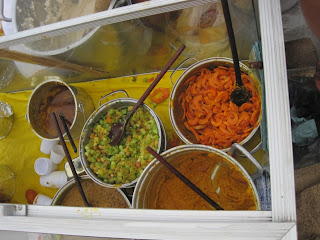11 Oct 2009
ACARAJÉAcarajé is one of the MOST traditional Bahian anything. It's an icon and so are the women who traditionally make them. They are called "Baianas" :). They are usually dressed in all white big skirts, shirts and a head scarf. Like most current Brazil is influenced by the history of colonization and slavery, so does the making of acarajé.
When Brazil was going through the exruciatingly slow process of emancipation of slavery, (it took centuries!) there were some free Black people who were either free because of the "Free womb" law, or because they paid their "masters" a satisfactory amount. This was one of the things that people did to earn money. Women were sometimes sent out to sell fruits on the streets for their masters who would receive most of the profit but sometimes they kept a little bit for themselves. Or there would be these groups juntos that were made up of several slaves and freed and they would all pitch in to buy people's freedom one by one but this way it was much faster than each individual waiting to accumulate enough money.
Then when slavery was abolished, there was no assistance from the government at all for all of these now unemployed people who now had to face racism. However many women, who came to be called ganhadeiras, found out ways to enter the business arena and it was usually by selling their products, sometimes fruits, and food like Acarajé, which is actually traditionally from Nigeria, and Ghana, Africa. It is still found in those countries and prepared almost exactly the same.
These ganhadeiras were actually where hollywood and industries got their ideas about the fruit hats. Because the ganhadeiras would carry the basket of the fruits they were selling on top of their heads.
This was the inspiration for Carmen Miranda:
 Very interesting that this Portuguese-born White woman became the face for not only Brazil but all of South/Latin America.
Very interesting that this Portuguese-born White woman became the face for not only Brazil but all of South/Latin America.And Chiquita Banana followed suit:
 So after the little history lesson this is Acarajé
So after the little history lesson this is Acarajé

A video on how it's made. There is a black eyed peas or beans made into a paste with ground dried shrimp and then it is fried in dendê (palm) oil which is very flavorful in itself. Then it is usually cut open and stuffed with tomatoes, shrimp, vatapá and carurú, which I've described before and are pictured below:
http://soniabrazilmorethanahottouristspot.blogspot.com/2009/12/caruru.html
 They work into the night too.
They work into the night too.ABARÁ
This one is the exact same thing except it is not fried, but wrapped in banana leaf and steamed much like tamales.


(This picture just shows a better view of the condiments)
I personally think that fried one is better, but abara is probably more healthful. But they're both worth trying if you're in Bahia or Rio de Janeiro.

No comments:
Post a Comment